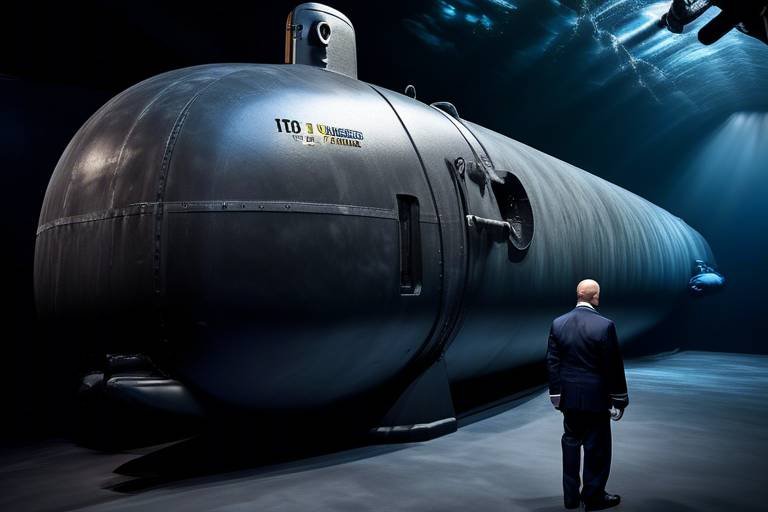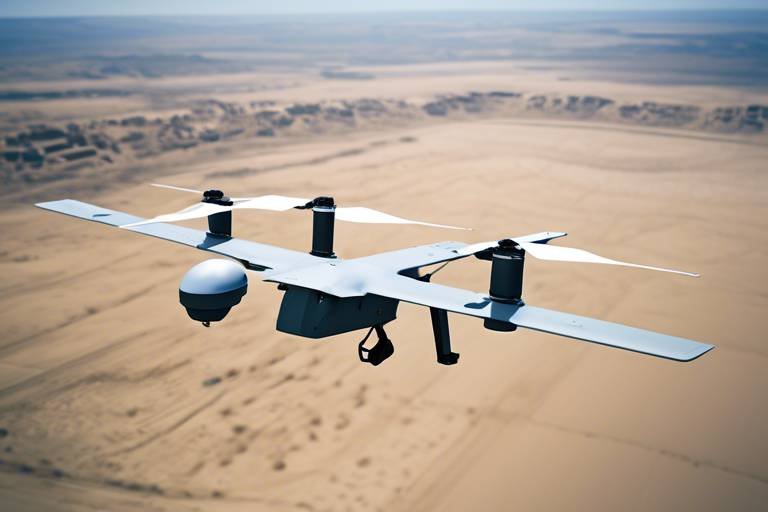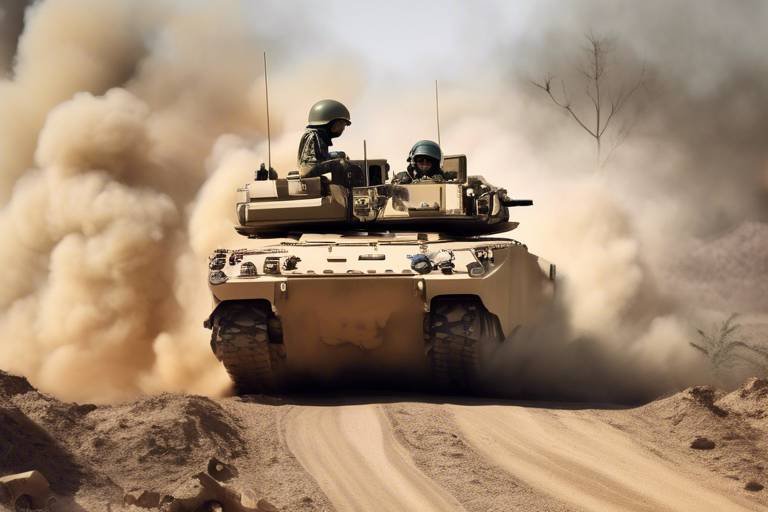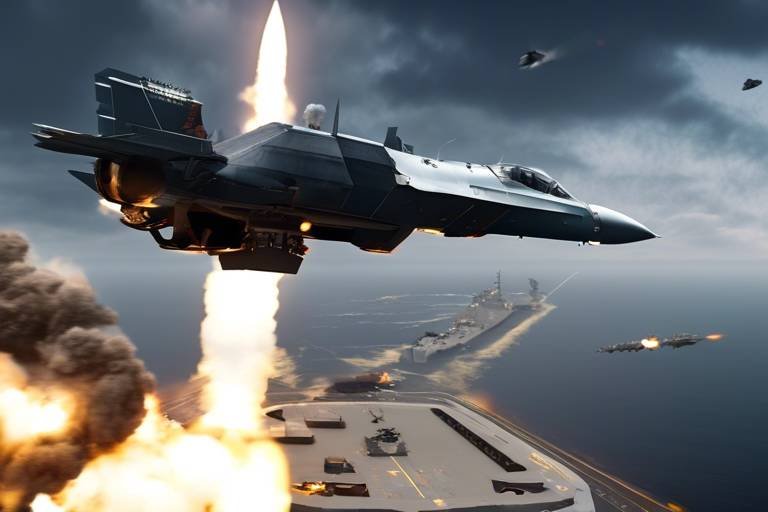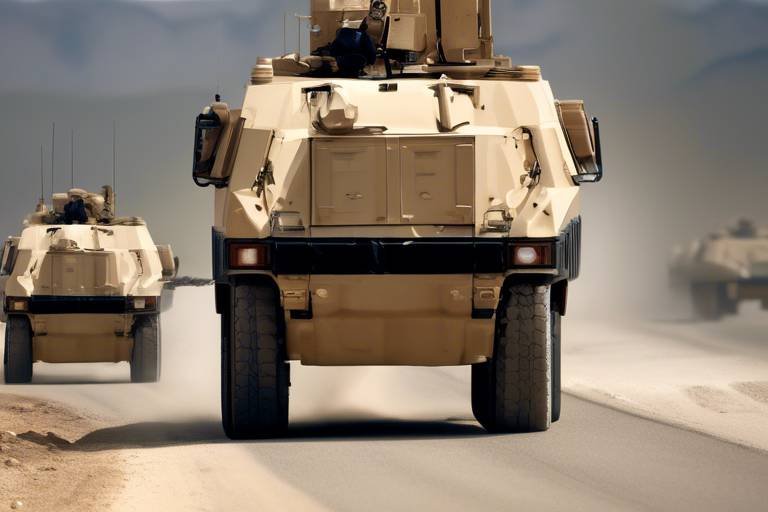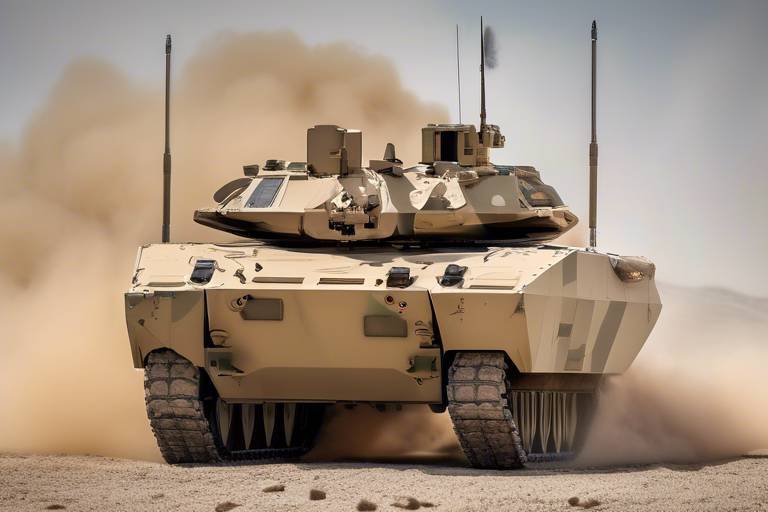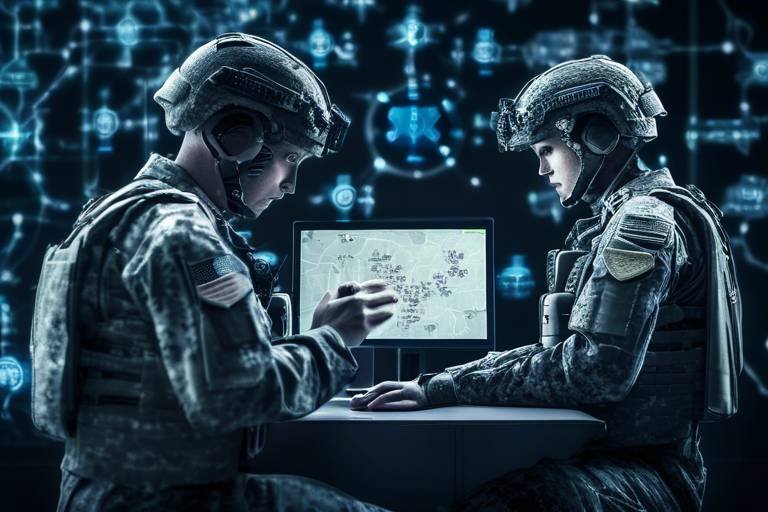The Future of Airborne Defense Systems in Modern Warfare
The landscape of modern warfare is rapidly evolving, and at the forefront of this transformation are airborne defense systems. These systems are not just a component of military strategy; they are becoming the backbone of national security. As we look to the future, it's essential to understand how advancements in technology and shifts in military tactics are shaping these systems. The integration of artificial intelligence, the challenges posed by cybersecurity, and the ethical implications of using such technologies are all critical considerations that will influence the future of warfare.
Imagine a world where military operations are conducted with the precision of a surgeon's scalpel rather than the blunt force of a hammer. This is the promise of modern airborne defense systems. They are designed to be agile, responsive, and incredibly accurate, allowing for rapid engagement of threats before they can cause harm. With innovations in radar technology, missile systems, and unmanned aerial vehicles (UAVs), military forces can now respond to threats with unprecedented speed and efficiency. This is not just about keeping up with potential adversaries; it's about staying ahead in a game of cat and mouse that is played on a global scale.
Furthermore, the integration of artificial intelligence into these systems is revolutionizing the way military operations are conducted. AI enhances decision-making processes, enabling real-time threat detection and response. For instance, AI-driven targeting systems can analyze vast amounts of data to identify potential threats, allowing for more precise engagement while minimizing collateral damage. This technology is not just a luxury; it is becoming a necessity in modern warfare, where the stakes are incredibly high, and the margin for error is razor-thin.
However, as we embrace these advancements, we must also confront the challenges they present. The interconnectedness of airborne defense systems raises significant cybersecurity concerns. As these systems become more reliant on digital networks, they become more vulnerable to cyber attacks that could compromise their effectiveness. Protecting these critical assets requires a robust cybersecurity strategy that includes constant monitoring and rapid response capabilities to mitigate potential threats.
As countries around the world adapt their military strategies to incorporate these advanced airborne defense systems, the implications for global military strategies are profound. Nations are not only enhancing their defensive capabilities but also reshaping international relations and defense policies. The arms race is no longer just about the number of weapons but about the sophistication of technology and the ability to leverage it in real-time scenarios.
In conclusion, the future of airborne defense systems in modern warfare is filled with both promise and peril. As we venture into this new era, it is crucial for military leaders, policymakers, and the global community to engage in open discussions about the ethical implications, regulatory frameworks, and the need for international cooperation to ensure that these powerful technologies are used responsibly and effectively.
- What are airborne defense systems? Airborne defense systems refer to military technologies designed to protect airspace from threats, including missiles, drones, and enemy aircraft.
- How does artificial intelligence improve airborne defense systems? AI enhances decision-making, automates threat detection, and improves targeting accuracy, leading to more efficient military operations.
- What are the cybersecurity risks associated with these systems? The interconnected nature of airborne defense systems makes them vulnerable to cyber attacks, which can compromise their functionality and effectiveness.
- Why are ethical considerations important in the use of airborne defense systems? The deployment of advanced technologies in warfare raises questions about civilian safety, accountability, and the moral implications of using autonomous weapons.

Advancements in Technology
In the fast-paced world of modern warfare, the are nothing short of revolutionary. The integration of cutting-edge innovations in radar, missile systems, and drone technology is reshaping airborne defense capabilities. Imagine a world where threats are identified and neutralized with unparalleled speed and precision. This is the reality we are moving towards, and it’s transforming military operations on a global scale.
One of the most significant breakthroughs has been in radar technology. Traditional radar systems have evolved into sophisticated networks capable of detecting and tracking multiple targets simultaneously, even in challenging environments. These advancements allow military forces to maintain situational awareness, making it easier to respond to potential threats before they escalate. With the ability to operate in various spectrums—such as phased array radars—the military can now detect stealth aircraft and other low-observable threats with remarkable accuracy.
Furthermore, the development of missile systems has reached new heights. Modern missiles are equipped with advanced guidance systems that utilize GPS, inertial navigation, and even terminal guidance to ensure they hit their targets with pinpoint accuracy. This not only increases the effectiveness of military operations but also significantly reduces the risk of collateral damage. In an age where precision is paramount, these technological advancements are game-changers.
Another area experiencing rapid growth is drone technology. Drones have become indispensable in modern warfare, serving a variety of roles from surveillance to direct combat. The ability to deploy unmanned aerial vehicles (UAVs) allows military forces to gather intelligence without risking human lives. Drones can be equipped with an array of sensors and weaponry, making them versatile tools in the arsenal of any military. Notably, the use of swarm technology is on the rise, where multiple drones can work together to overwhelm defenses, creating a tactical advantage that was previously unimaginable.
As we look to the future, the integration of these technologies will only deepen. The synergy between radar, missile systems, and drones is paving the way for a new era of warfare where speed and precision are paramount. It's essential for military strategists to stay ahead of the curve, adapting to these advancements to maintain a competitive edge. The implications for global security are profound, as nations race to enhance their airborne defense capabilities.
In conclusion, the advancements in technology are not just enhancing airborne defense systems; they are redefining the entire landscape of modern warfare. As we continue to innovate and integrate these technologies, the future of military operations will be shaped by the ability to respond to threats with unmatched speed and accuracy.

Integration with Artificial Intelligence
Artificial intelligence (AI) is no longer just a futuristic concept; it is becoming a cornerstone of modern airborne defense systems. The integration of AI technologies is revolutionizing how military forces detect, engage, and neutralize threats. Imagine a world where machines can analyze vast amounts of data in seconds, making split-second decisions that could mean the difference between victory and defeat. This is the reality that AI is bringing to the battlefield.
One of the most significant advantages of AI in airborne defense is its ability to enhance decision-making processes. With the sheer volume of data generated during military operations, human operators can easily become overwhelmed. AI algorithms can sift through this information, identifying patterns and anomalies that might go unnoticed by the human eye. This capability not only speeds up the response time but also improves the accuracy of threat identification, allowing for more effective countermeasures.
Moreover, AI-driven systems are capable of automating threat detection. For instance, advanced algorithms can monitor airspace for potential threats, analyzing flight patterns and behaviors in real-time. When a suspicious object is detected, the system can automatically initiate protocols to assess the situation further. This level of automation reduces the burden on human operators, enabling them to focus on higher-level strategic decisions while AI handles routine monitoring tasks.
One of the most intriguing applications of AI in airborne defense is in the realm of targeting systems. These AI-driven systems can engage threats with remarkable precision, significantly reducing the risk of collateral damage. Imagine a missile system that can differentiate between a hostile target and civilian infrastructure in real-time. This capability not only enhances mission success rates but also mitigates the ethical concerns associated with modern warfare.
Additionally, AI can facilitate real-time data analysis, allowing military forces to adapt their tactics on the fly. For example, if an airborne threat changes its course unexpectedly, AI systems can instantly process this new information and recommend an alternative response strategy. This adaptability is crucial in high-stakes environments where every second counts.
Another critical aspect of AI integration is its role in predictive maintenance. By analyzing data from various sensors within airborne defense systems, AI can predict when a component is likely to fail. This proactive approach to maintenance minimizes downtime and ensures that systems are always ready for action. In a landscape where every moment matters, the ability to maintain operational readiness can be a game-changer.
In summary, the integration of AI into airborne defense systems is not just about enhancing capabilities; it is about reshaping the entire operational landscape. The synergy between human intelligence and artificial intelligence creates a powerful force multiplier that can redefine military strategies and outcomes.
- What is the role of AI in airborne defense systems?
AI enhances decision-making, automates threat detection, and improves targeting accuracy, making military operations more efficient and effective. - How does AI improve maintenance for defense systems?
AI analyzes sensor data to predict when components may fail, allowing for timely maintenance and ensuring systems remain operational. - Are there ethical concerns with AI in military applications?
Yes, there are ongoing debates about the use of AI in warfare, particularly regarding accountability and the potential for collateral damage.

AI-Driven Targeting Systems
The emergence of is nothing short of revolutionary in the realm of airborne defense. Imagine a world where military operations are not just reactive but proactive, where decisions are made in the blink of an eye, and where the accuracy of engagement is elevated to unprecedented levels. This is the promise of artificial intelligence in military targeting. These systems utilize vast amounts of data, processing it at lightning speed to identify, classify, and prioritize threats. In this age of information overload, AI acts as a filter, sifting through the noise to pinpoint the most pressing dangers.
One of the significant advantages of AI-driven targeting systems is their ability to reduce collateral damage. Traditional targeting methods often involve a degree of guesswork, leading to unintended consequences. However, with AI, the systems can analyze multiple variables, such as the location of civilians, the type of threat, and the best course of action, all in real-time. This capability not only increases the chances of mission success but also enhances the ethical considerations surrounding military operations. By minimizing civilian casualties, these systems contribute to a more responsible approach to warfare.
Moreover, the integration of AI in targeting systems facilitates a shift in combat strategies. As these systems become more sophisticated, they allow for multi-target engagement, meaning that a single operator can manage several threats simultaneously. This is akin to a conductor leading an orchestra, where each instrument plays in harmony, creating a symphony of precise military action. This level of coordination can significantly alter the dynamics of battlefield engagements, enabling forces to respond to multiple threats with agility and efficiency.
To illustrate the impact of AI-driven targeting systems, consider the following table that summarizes key features and benefits:
| Feature | Benefit |
|---|---|
| Real-time threat assessment | Faster decision-making and response times |
| Data fusion from multiple sources | Improved accuracy in identifying targets |
| Automated engagement protocols | Reduced operator workload and enhanced operational tempo |
| Predictive analytics | Anticipation of enemy movements and strategies |
However, the reliance on AI-driven systems is not without its challenges. The technology must be rigorously tested and validated to ensure reliability in high-stakes environments. Additionally, the potential for malfunction or hacking raises concerns about the security of these systems. As we embrace these advancements, it becomes crucial to implement robust cybersecurity measures to safeguard against potential threats that could compromise military operations.
In conclusion, AI-driven targeting systems represent a significant leap forward in airborne defense technology. They not only enhance operational effectiveness but also contribute to a more ethical approach to military engagements. As nations continue to invest in and refine these technologies, the implications for global security and military strategy will be profound, shaping the future of warfare in ways we are only beginning to understand.
- What are AI-driven targeting systems? - These are advanced military systems that use artificial intelligence to identify and engage threats with high precision and speed.
- How do these systems reduce collateral damage? - By analyzing various data points in real-time, AI systems can make informed decisions that consider the presence of civilians and minimize unintended harm.
- What are the security concerns associated with AI in military operations? - The potential for hacking or system failures poses significant risks that necessitate strong cybersecurity measures.
- How do AI-driven systems change combat strategies? - They enable multi-target engagement and faster decision-making, allowing forces to adapt dynamically to battlefield conditions.

Real-Time Data Analysis
In the fast-paced world of modern warfare, has emerged as a game-changer for airborne defense systems. Imagine being in a high-stakes chess match where every move counts; this is precisely how military operations unfold on the battlefield. With the ability to process vast amounts of data instantly, commanders can make informed decisions that could mean the difference between victory and defeat.
Real-time data analysis involves the continuous collection and assessment of information from various sources, including radar systems, satellite imagery, and even social media feeds. This interconnected web of data provides a comprehensive view of the operational landscape. For example, if a hostile aircraft is detected, the system can analyze its trajectory, speed, and potential threat level in seconds, allowing for a swift and precise response. The integration of this technology not only enhances situational awareness but also optimizes resource allocation, ensuring that the right assets are deployed at the right time.
Furthermore, the ability to analyze data in real-time facilitates adaptive tactics. In the heat of battle, conditions can change rapidly; enemy movements, weather patterns, and even civilian presence can shift the dynamics of engagement. By utilizing advanced algorithms and machine learning, airborne defense systems can adjust their strategies on-the-fly. This is akin to a skilled musician improvising during a live performance, seamlessly adapting to the rhythm of the moment.
To illustrate the impact of real-time data analysis, consider the following table that outlines its key benefits:
| Benefit | Description |
|---|---|
| Enhanced Decision-Making | Provides commanders with comprehensive situational awareness for informed choices. |
| Improved Response Times | Facilitates immediate action against threats, minimizing reaction delays. |
| Resource Optimization | Ensures efficient deployment of military assets based on real-time needs. |
| Adaptive Strategies | Allows for quick adjustments to tactics based on evolving battlefield conditions. |
Moreover, the implications of real-time data analysis extend beyond immediate tactical advantages. By accumulating and processing data over time, military forces can identify patterns and trends that inform future operations. This predictive capability can lead to more effective training programs and strategic planning, ultimately enhancing overall military readiness.
As we venture into an era where warfare increasingly relies on technology, the importance of real-time data analysis cannot be overstated. It’s not just about having the latest gadgets; it’s about how effectively these tools are integrated into the decision-making framework of military operations. In essence, real-time data analysis transforms raw information into actionable intelligence, paving the way for a future where airborne defense systems are not only reactive but also proactive in safeguarding national security.
In conclusion, as we witness the evolution of airborne defense systems, the role of real-time data analysis stands out as a critical component. It empowers military forces to respond swiftly and effectively to emerging threats, ensuring that they remain one step ahead in the ever-changing landscape of modern warfare.
- What is real-time data analysis in military operations?
Real-time data analysis involves the immediate processing of data from various sources to enhance situational awareness and decision-making during military engagements. - How does real-time data analysis improve response times?
By providing instant access to critical information, commanders can quickly assess threats and deploy appropriate resources without delay. - Can real-time data analysis predict future military trends?
Yes, by analyzing historical data and identifying patterns, military forces can make informed predictions about future operational needs and strategies.

Predictive Maintenance
In the realm of airborne defense systems, has emerged as a game-changer, enabling military forces to maintain peak operational readiness while minimizing unexpected failures. Imagine a scenario where advanced technology can foresee potential issues before they escalate into critical failures. This is precisely what predictive maintenance aims to achieve, utilizing a blend of data analytics, machine learning, and real-time monitoring to keep airborne defense systems in optimal condition.
At its core, predictive maintenance leverages sensor data from various components within an aircraft or drone. This data is continuously collected and analyzed to identify patterns that may indicate wear and tear. For instance, if a sensor detects an unusual vibration pattern in a jet engine, the system can alert maintenance crews to inspect the engine before a failure occurs. This proactive approach not only enhances the reliability of airborne systems but also extends their lifespan, ultimately saving military budgets.
Moreover, the integration of predictive maintenance into defense strategies allows for a more efficient allocation of resources. Rather than adhering to a rigid maintenance schedule, which may lead to unnecessary downtime or, conversely, missed opportunities for repairs, military operations can now adopt a more fluid approach. This flexibility ensures that aircraft are available when needed most, particularly during critical missions where every second counts.
To illustrate the effectiveness of predictive maintenance, consider the following table that highlights key benefits:
| Benefit | Description |
|---|---|
| Increased Readiness | Ensures that airborne systems are always mission-ready by predicting and addressing maintenance needs before they become critical. |
| Cost Efficiency | Reduces maintenance costs by preventing major repairs and extending the lifespan of equipment. |
| Enhanced Safety | Minimizes the risk of accidents caused by equipment failure, thereby safeguarding personnel and assets. |
Furthermore, predictive maintenance is not just about fixing problems; it’s about creating a culture of continuous improvement. As data is collected and analyzed, insights can be gleaned not only about the systems themselves but also about operational practices and environmental conditions that affect performance. This feedback loop allows military organizations to refine their strategies and improve overall mission success rates.
In conclusion, the implementation of predictive maintenance in airborne defense systems is a critical advancement that aligns with the broader goals of modern military operations. By harnessing the power of technology, armed forces can ensure that their assets remain reliable, efficient, and ready to respond to any threat. As we look to the future, the importance of predictive maintenance will only continue to grow, shaping the way military operations are conducted and enhancing global security.
- What is predictive maintenance? Predictive maintenance is a proactive maintenance strategy that uses data analytics to predict when equipment failures might occur, allowing for timely repairs.
- How does predictive maintenance benefit military operations? It increases operational readiness, reduces costs, and enhances safety by preventing unexpected equipment failures.
- What technologies are used in predictive maintenance? Technologies include sensors, data analytics software, and machine learning algorithms.
- Can predictive maintenance be applied to other areas outside of military operations? Yes, predictive maintenance is widely used in various industries, including aviation, manufacturing, and automotive sectors.

Challenges of Cybersecurity
The rapid evolution of airborne defense systems has introduced a myriad of challenges, particularly in the realm of cybersecurity. As these systems become increasingly interconnected, the potential for cyber attacks grows exponentially. Imagine a scenario where a military drone, designed to protect a nation, becomes the target of a sophisticated hacker. This isn't just a plot from a sci-fi movie; it's a real concern that military strategists must grapple with today.
One of the primary challenges is the sheer complexity of these systems. Modern airborne defense mechanisms rely on a network of sensors, data analytics, and communication protocols that must work seamlessly together. Each component, while enhancing operational capabilities, also presents a potential entry point for cyber threats. For instance, if an attacker can infiltrate the communication channels, they may gain control over critical systems, leading to catastrophic outcomes.
Moreover, the speed at which technology is advancing means that cybersecurity measures often struggle to keep pace. Military organizations are racing to implement cutting-edge technologies, but this haste can lead to vulnerabilities. A recent report highlighted that nearly 60% of military personnel believe their systems are not adequately protected against cyber threats. This statistic underscores the urgent need for robust cybersecurity frameworks.
To combat these challenges, military forces are adopting a multi-layered approach to cybersecurity. This includes:
- Regular Audits: Continuous evaluation of systems to identify and rectify vulnerabilities.
- Training Personnel: Ensuring that military personnel are well-versed in cybersecurity protocols.
- Collaboration with Tech Firms: Partnering with technology companies to leverage their expertise in cybersecurity solutions.
Furthermore, the rise of Artificial Intelligence in cybersecurity is proving to be a double-edged sword. While AI can enhance threat detection and response, it can also be weaponized by adversaries to launch more sophisticated attacks. This arms race in the cyber domain necessitates a proactive stance, where military organizations must anticipate potential threats and develop countermeasures before they are exploited.
In conclusion, the challenges posed by cybersecurity in airborne defense systems are significant and multifaceted. As technology continues to evolve, so too must the strategies to protect these critical assets. The stakes are high, and the implications of failing to address these challenges could jeopardize not only military operations but also global security as a whole.
- What are the main cybersecurity threats to airborne defense systems? Cybersecurity threats include hacking attempts, malware attacks, and unauthorized access to sensitive data.
- How can military organizations improve their cybersecurity? By conducting regular audits, training personnel, and collaborating with technology firms for advanced solutions.
- Is AI beneficial or harmful to cybersecurity in military applications? AI can enhance threat detection but can also be used by adversaries to launch sophisticated attacks, making it a double-edged sword.

Global Military Strategies
The landscape of global military strategies is undergoing a significant transformation, largely driven by the integration of advanced airborne defense systems. As nations recognize the importance of air superiority, they are adapting their military frameworks to incorporate these sophisticated technologies. The implications of this shift are profound, influencing not only national defense policies but also international relations. Countries that invest in cutting-edge airborne defense systems often gain a strategic advantage, reshaping the balance of power on a global scale.
For instance, nations like the United States, Russia, and China are at the forefront of this evolution. Each country is developing unique strategies that leverage airborne capabilities to enhance their military effectiveness. The United States focuses on a multi-domain approach, integrating airborne systems with land, sea, and cyber capabilities. This holistic strategy allows for a comprehensive defense posture that can respond to a variety of threats. On the other hand, Russia emphasizes electronic warfare and anti-access/area denial (A2/AD) strategies, aiming to deter adversaries through robust airborne defenses.
Moreover, the rapid advancements in drone technology and missile systems are prompting countries to rethink their military doctrines. The ability to deploy unmanned aerial vehicles (UAVs) for surveillance and combat roles has changed the traditional dynamics of warfare. Nations are increasingly investing in these technologies to enhance their reconnaissance capabilities and strike precision. This shift not only affects military operations but also has significant implications for global security and geopolitical tensions.
As countries adapt their military strategies, we also see a growing trend towards collaboration and alliances. For example, NATO has been actively integrating airborne defense systems among its member states, fostering interoperability and collective defense. This cooperation is crucial in addressing emerging threats, such as cyber warfare and asymmetric conflicts, where traditional military strategies may fall short.
In summary, the integration of advanced airborne defense systems is reshaping global military strategies. Nations are not only enhancing their capabilities but also rethinking their approaches to warfare and international relations. As we look to the future, it is clear that airborne systems will play a pivotal role in defining military effectiveness and global security dynamics.
- What are airborne defense systems? Airborne defense systems refer to military technologies designed to protect airspace from threats such as missiles and enemy aircraft.
- How do airborne defense systems influence military strategies? They provide nations with enhanced capabilities for surveillance, reconnaissance, and engagement, leading to a re-evaluation of traditional military doctrines.
- What role does AI play in airborne defense systems? AI improves decision-making, automates threat detection, and enhances targeting systems, significantly increasing operational efficiency.
- Why is cybersecurity a concern for airborne defense systems? As these systems become more interconnected, they are vulnerable to cyber attacks, which can compromise their effectiveness and security.
- What ethical considerations arise from the use of advanced airborne defense systems? The deployment of such technologies raises questions about civilian safety, accountability in warfare, and the potential for misuse.

Case Studies of Implementation
When we talk about the implementation of airborne defense systems, it’s essential to look at real-world examples that showcase their effectiveness and adaptability. Various nations have successfully integrated these advanced technologies into their military frameworks, leading to significant improvements in their defense capabilities. One notable case is the United States, which has invested heavily in its Integrated Air and Missile Defense (IAMD) systems. These systems combine various technologies, including radar, interceptors, and command and control, to create a multi-layered defense against aerial threats. The Ground-based Midcourse Defense (GMD) system, for instance, has been pivotal in intercepting incoming ballistic missiles, demonstrating the importance of a robust airborne defense strategy.
Another compelling example comes from Israel, known for its innovative defense technologies. The Iron Dome system has gained international acclaim for its ability to intercept short-range threats such as rockets and artillery shells. What sets the Iron Dome apart is its real-time decision-making capabilities, which allow it to evaluate threats and determine whether to intercept based on potential damage. This system has not only saved countless lives but has also become a model for other nations looking to enhance their aerial defense systems.
In Europe, the European Sky Shield Initiative represents a collaborative effort among several nations to strengthen their airborne defense. This initiative focuses on integrating various air defense systems across borders to create a unified defense network. By sharing intelligence and resources, participating countries aim to enhance their collective security against evolving threats. The implications of such cooperation extend beyond military effectiveness; they also foster diplomatic ties and mutual trust among nations.
To better understand the impact of these implementations, we can look at a comparative analysis of these systems:
| Country | System | Key Features | Impact |
|---|---|---|---|
| United States | Ground-based Midcourse Defense (GMD) | Multi-layered defense, ballistic missile interception | Enhanced national security, deterrence capability |
| Israel | Iron Dome | Real-time threat evaluation, short-range interception | Significant reduction in civilian casualties |
| Europe | European Sky Shield Initiative | Collaborative defense network, shared resources | Strengthened alliances, improved regional security |
These case studies not only highlight the technological advancements in airborne defense systems but also underscore the importance of strategic implementation. Each example demonstrates that while technology is crucial, the way it is integrated into military strategy can significantly affect its success. By learning from these implementations, other nations can better prepare for the challenges of modern warfare.
Q1: What are airborne defense systems?
Airborne defense systems are military technologies designed to detect, intercept, and neutralize aerial threats, including missiles, drones, and enemy aircraft. They play a critical role in national security.
Q2: How do these systems impact modern warfare?
These systems enhance a country's defensive capabilities, allowing for quicker responses to threats, reduced collateral damage, and improved overall mission success rates.
Q3: What role does artificial intelligence play in airborne defense?
Artificial intelligence improves decision-making processes, automates threat detection, and enables real-time data analysis, making airborne defense systems more efficient and effective.
Q4: Are there ethical concerns regarding airborne defense systems?
Yes, the deployment of advanced technologies raises moral questions about civilian safety, accountability, and the implications of using autonomous weapons in combat.

Future Trends in Warfare
The landscape of warfare is undergoing a seismic shift, driven largely by advancements in airborne defense systems. As we peer into the future, several trends are emerging that will redefine how nations engage in conflict. One of the most striking trends is the increasing reliance on unmanned aerial vehicles (UAVs), commonly known as drones. These flying machines are not just tools for surveillance; they are becoming integral to combat operations, offering capabilities that were once the realm of science fiction.
Imagine a battlefield where drones can autonomously identify and engage targets with pinpoint precision, minimizing the risk to human soldiers. This is not a distant dream; it is rapidly becoming our reality. The evolution of drone technology includes swarm tactics, where multiple drones operate in unison, overwhelming enemy defenses and executing complex maneuvers that would be impossible for a single pilot. This concept, akin to a flock of birds coordinating their flight, showcases the potential for enhanced operational efficiency and tactical superiority.
Moreover, the integration of AI and machine learning into airborne systems is paving the way for predictive analytics in warfare. With the ability to analyze vast amounts of data in real-time, military strategists can anticipate enemy movements and adjust their tactics accordingly. This capability is like having a chess master who can foresee several moves ahead, allowing for proactive rather than reactive strategies.
However, it's not just about drones and AI. The future of warfare will also see a significant shift towards hybrid warfare, where conventional military tactics are blended with cyber operations and information warfare. Nations will not only need to defend their airspace but also their digital infrastructure. The battle will extend beyond physical engagements into the realm of cybersecurity, where the ability to disrupt enemy communications and command structures could determine the outcome of conflicts.
As we look at these trends, it's crucial to consider their implications on international relations. Countries that invest heavily in advanced airborne defense systems may gain a strategic advantage, but this can also lead to an arms race, where nations feel compelled to enhance their military capabilities in response to perceived threats. The potential for escalation is high, and the balance of power could shift dramatically.
In summary, the future of warfare is poised for transformation. With the rise of UAVs, AI-driven strategies, and hybrid warfare approaches, military operations will become more complex and multifaceted. As we navigate this new terrain, it is imperative for policymakers and military leaders to consider the ethical implications and the need for international regulations to govern the use of these powerful technologies. The question remains: how will nations adapt to these changes, and what measures will they take to ensure global security in an increasingly volatile world?
- What role do drones play in modern warfare? Drones are increasingly used for surveillance, reconnaissance, and targeted strikes, providing military forces with enhanced operational capabilities.
- How is AI changing military strategies? AI enhances decision-making processes, enabling faster and more accurate targeting and predictive analytics in combat scenarios.
- What are the ethical concerns surrounding autonomous weapons? The use of autonomous weapons raises questions about accountability, civilian safety, and the potential for misuse in conflict situations.
- How can nations ensure cybersecurity in military operations? Nations must invest in robust cybersecurity measures to protect their airborne defense systems from cyber threats and attacks.

Ethical Considerations
The deployment of advanced airborne defense systems has opened a Pandora's box of ethical questions that society cannot afford to ignore. As military technologies evolve, so do the moral implications surrounding their use. One of the most pressing concerns is the potential for civilian casualties. With high-tech systems capable of engaging targets with pinpoint accuracy, the expectation is that collateral damage will be minimized. However, the reality is often more complex. How do we ensure that these systems distinguish between combatants and non-combatants? The integration of artificial intelligence (AI) in targeting systems raises further questions about accountability. If an autonomous drone makes a mistake, who is responsible? The operator? The manufacturer? Or is it the algorithm that failed? These are not just theoretical dilemmas; they are real-world issues that demand immediate attention.
Moreover, as we embrace these technologies, we must consider the broader implications for global security. The proliferation of advanced airborne defense systems could lead to an arms race among nations, as countries scramble to develop their own capabilities. This competitive dynamic can destabilize regions and escalate conflicts, making the world a more dangerous place. It's essential to establish international norms and agreements that govern the use of such technologies, to prevent misuse and ensure accountability. The question remains: can we create a framework that balances military effectiveness with ethical responsibility?
In addition, the rise of autonomous weapons has sparked a heated debate among ethicists, military strategists, and policymakers. Proponents argue that these systems can reduce human error and improve operational efficiency. On the other hand, critics warn that removing humans from the decision-making process could lead to catastrophic outcomes. The moral implications of allowing machines to make life-and-death decisions are profound. Are we ready to trust algorithms with such power? Should there be limits on the autonomy of weapons systems? These questions challenge us to rethink our approach to warfare in the age of technology.
To better understand these ethical considerations, it's helpful to look at some key points:
- Civilian Safety: How can we ensure that advanced systems do not harm innocent lives?
- Accountability: Who is responsible when an autonomous system fails?
- Global Stability: Will the proliferation of these systems lead to an arms race?
- Autonomy in Decision-Making: Should machines have the power to make combat decisions?
As we navigate these complex issues, it is critical to engage in open dialogues and seek collaborative solutions that prioritize ethical considerations alongside military objectives. The future of warfare is not just about technological superiority; it is also about the moral compass that guides our actions. The decisions we make today will shape the landscape of global security for generations to come.
Q1: What are the main ethical concerns regarding airborne defense systems?
A1: The primary concerns include civilian safety, accountability for autonomous systems, the potential for an arms race, and the moral implications of allowing machines to make combat decisions.
Q2: How can we ensure the safety of civilians in military operations?
A2: Implementing strict guidelines and protocols for target identification, using AI responsibly, and maintaining human oversight in decision-making processes can help minimize civilian casualties.
Q3: Is there a need for international regulations on airborne defense systems?
A3: Yes, establishing international norms and agreements is crucial to prevent misuse of these technologies and to promote accountability among nations.
Q4: What role does artificial intelligence play in airborne defense systems?
A4: AI enhances targeting accuracy, automates threat detection, and can improve decision-making processes, but it also raises ethical concerns regarding accountability and the potential for unintended consequences.

Autonomous Weapons Debate
The rise of autonomous weapons in airborne defense systems has ignited a heated debate that intertwines technology, ethics, and the future of warfare. On one hand, proponents argue that these systems can significantly enhance military effectiveness, enabling faster response times and reducing the risk to human soldiers. Imagine a battlefield where drones equipped with advanced AI can identify and neutralize threats without human intervention—sounds like something out of a sci-fi movie, right? But, on the other hand, critics raise serious concerns about the moral implications of allowing machines to make life-and-death decisions.
One of the most pressing issues revolves around the idea of accountability. If an autonomous weapon mistakenly targets civilians, who is held responsible? The manufacturer? The military? Or the AI itself? This ambiguity creates a legal and ethical quagmire that could have dire consequences. Furthermore, there's the fear that such systems could be hacked or malfunction, leading to catastrophic outcomes. In a world where cybersecurity threats are rampant, the thought of a rogue drone wreaking havoc is chilling.
Moreover, the debate extends beyond the immediate implications of using autonomous weapons. It raises fundamental questions about the nature of warfare itself. Traditionally, warfare has been a human endeavor, steeped in strategy and moral considerations. With the advent of AI-driven systems, we must ask ourselves: Are we prepared to cede the moral authority of warfare to algorithms? The implications of this shift could redefine the very essence of combat, turning it into a cold, calculated affair devoid of human empathy.
In light of these concerns, many experts advocate for the establishment of international regulations governing the use of autonomous weapons. Such regulations could help ensure that these technologies are used responsibly and ethically. For instance, a framework could be developed to mandate human oversight in critical decisions made by autonomous systems, ensuring that moral considerations remain at the forefront of military operations.
As we navigate this complex landscape, it's essential to engage in open dialogue about the future of autonomous weapons. The conversation must involve not only military leaders and policymakers but also ethicists, technologists, and the public. After all, the decisions we make today regarding these technologies will shape the nature of warfare for generations to come.
- What are autonomous weapons? Autonomous weapons are systems that can operate independently, making decisions without human intervention, often using artificial intelligence.
- What are the ethical concerns surrounding autonomous weapons? Major ethical concerns include accountability for mistakes, the potential for misuse, and the moral implications of machines making life-and-death decisions.
- Should there be regulations on the use of autonomous weapons? Many experts believe that international regulations are necessary to ensure responsible and ethical use of these technologies in warfare.
- How might autonomous weapons change the nature of warfare? They could lead to faster, more efficient military operations but also raise questions about the moral implications and human oversight in combat.

International Regulations
The rapid advancement of airborne defense systems has led to a pressing need for that govern their use. As nations invest heavily in these technologies, the question arises: how can we ensure that their deployment does not spiral out of control? The importance of establishing a robust framework for regulation cannot be overstated, as it holds the potential to prevent misuse and mitigate the risks associated with these powerful systems.
One of the primary challenges in creating international regulations for airborne defense systems is the diverse landscape of military capabilities across countries. Nations with advanced technologies may have different strategic interests compared to those with less sophisticated systems. This disparity can lead to tensions and conflicts, making it crucial to establish norms that are acceptable to all parties involved. The United Nations and other international bodies play a pivotal role in facilitating discussions and negotiations to develop these regulations.
Moreover, the rapid pace of technological innovation often outstrips the ability of regulatory bodies to keep up. For instance, the emergence of unmanned aerial vehicles (UAVs) and autonomous systems has raised significant questions about accountability and the ethical use of force. Who is responsible when an autonomous drone makes a mistake? How do we ensure that these systems are not used for unlawful purposes? These questions are at the forefront of the debate surrounding international regulations.
To address these concerns, a multi-faceted approach is necessary. This could include:
- Establishing clear definitions and classifications for different types of airborne defense systems.
- Creating guidelines for the ethical use of autonomous weapons and ensuring accountability.
- Promoting transparency in military operations involving airborne systems to build trust among nations.
In addition, there is a growing call for international treaties that specifically address the use of airborne defense technologies. Such treaties could set limits on the development and deployment of certain systems, similar to existing frameworks for nuclear weapons. However, achieving consensus among nations is often a daunting task, as national security interests frequently clash with the desire for global stability.
Ultimately, the goal of international regulations should be to create a safe and secure environment where airborne defense systems can be used responsibly. As we look to the future, fostering cooperation and dialogue among nations will be essential in shaping the regulatory landscape. Only through collaboration can we hope to navigate the complexities of modern warfare and ensure that these powerful technologies serve to protect rather than endanger global security.
- What are airborne defense systems?
Airborne defense systems refer to military technologies designed to detect, intercept, and neutralize aerial threats, including missiles and enemy aircraft. - Why are international regulations necessary for airborne defense systems?
International regulations are essential to prevent misuse, ensure accountability, and promote stability among nations, especially as these technologies become more advanced and widespread. - What role do international organizations play in regulating defense technologies?
Organizations like the United Nations facilitate discussions, promote treaties, and help establish norms for the use of military technologies, including airborne defense systems. - How can nations ensure the ethical use of autonomous weapons?
Nations can establish guidelines, promote transparency, and foster international cooperation to ensure that autonomous weapons are used ethically and responsibly.
Frequently Asked Questions
- What are airborne defense systems?
Airborne defense systems are military technologies designed to detect, track, and neutralize aerial threats. These can include missiles, drones, and enemy aircraft, utilizing advanced radar, missile systems, and drones to ensure airspace security.
- How has technology advanced in airborne defense systems?
Recent innovations have led to faster response times and improved accuracy in targeting threats. Key advancements include enhanced radar systems, more sophisticated missile technologies, and the integration of unmanned aerial vehicles (UAVs) that can operate autonomously or remotely.
- What role does artificial intelligence play in airborne defense?
Artificial intelligence significantly enhances airborne defense systems by automating threat detection, improving decision-making processes, and enabling real-time data analysis. This results in more efficient operations and higher success rates in military engagements.
- What are AI-driven targeting systems?
AI-driven targeting systems use machine learning algorithms to identify and engage threats with precision. This technology minimizes collateral damage and increases the likelihood of mission success by allowing for quick adjustments based on real-time data.
- How do airborne defense systems handle cybersecurity threats?
As these systems become more interconnected, they face increased cybersecurity risks. To mitigate these threats, military organizations implement robust cybersecurity measures, including encryption, regular software updates, and continuous monitoring for vulnerabilities.
- What are the ethical implications of using advanced airborne defense systems?
The deployment of such technologies raises significant ethical questions regarding civilian safety, accountability, and the moral implications of automated warfare. Discussions are ongoing about the responsibilities of military personnel in managing these systems.
- Are there international regulations governing airborne defense technologies?
Yes, there is a growing need for international regulations to govern the use of airborne defense technologies. Establishing norms is crucial to prevent misuse and escalation of conflicts, ensuring that these powerful tools are used responsibly.
- What trends are emerging in modern warfare due to airborne defense systems?
Emerging trends include a shift towards unmanned aerial vehicles (UAVs) and increased reliance on AI for combat strategies. These changes influence how nations approach military operations and international relations.


